Original Text from blog of Great East Japan Earthquake Relief Network in West-Chiba http://2011shinsaichiba.seesaa.net/article/273921452.html
* 2012 June 9. As i added data of adults, the original title "child morbidity and mortality on a rise in the contaminated regions" was modified. Also, new contamination map includes Aomori, Ishikawa, Fukui and Aichi.
According to a report, the number of cases of disease and death of children from 1 to19-year-old increased in prefecture Fukushima in 2011 (March-November) compared to the previous year. Likewise, in prefecture Chiba, increase was reported in the case of young people from 4 to 29-year-old, while decrease was seen in the case of children under 4-year-old.
2012 May 14. Child morbidity and mortality in prefecture Fukushima - Development analyzed based on Population Survey Report (Seiichi Nakate)
2012 May 29. Declining child morbidity/mortality reversed in prefecture Chiba in 2011(Mitsuyuki Ohta)
As the number of cases of disease and death of children is originally small, the amount of data is not sufficient to associate it with the radiation. So, I analyzed data of all the prefectures in east Japan, including Gifu, Aichi, Toyama, Ishikawa and Fukui, to study the relationship between the contamination level and increase or decrease of disease and death.
I estimated death toll using Population Survey Report. (by subtracting "the cause of injuries, diseases and death from the total.) Unfortunately, 2008/2009 cause-specific, age-specific data and data by prefecture are unavailable, so I compared only 2010 data and 2011 data (Mar-Nov). Population change is less significant than morbidity and mortality change, therefore, I didn't evaluate mortality rate (the number of cases of disease and death divided by population). Many cases of child death are infants, so I separated infants to make a careful study of other age brackets, made three groups according to age (infant, 1-4-year old, 5-19-year old) and then tallied the number of cases of disease and death. As adult morbidity and mortality are larger than children, I made groups of each 10 years.
Population Survey Report / issued by Health, Labour and Welfare Ministry
monthly report (round)
Fig.1 and Fig.2 are the result of children. Fig.3 and Fig.4 are adult's.
It's evident that the prefectures that have at least 1.5 times bigger number of cases of disease and death of any one of 3 groups of children than the previous year are Iwate, Yamagata, Fukushima, Tochigi, Chiba and Nagano. Those are the prefectures that are radiation-contaminated.
Then, Shizuoka (group of 1-4-year old 1.41 times more) and Saitama (group of 5-19-year old 1.36 times more) follow.
As for adult, the prefectures that have at least 1.2 times bigger number of cases of disease and death of any one of brackets compared to the previous year are Miyagi, Akita, Yamagata, Fukushima, Tochigi, Gunma, Chiba, Toyama. The result of Iwate (group of 20-29-year old, 0.56 times more) is especially remarkable. The number of cases of disease and death of some age brackets in these prefectures declined over the previous year. However, the year-on-year increases were marked in these 6 prefectures, as well as Akita and Toyama (Some areas of Toyama are also contaminated).
It is very likely the number of cases of disease and death increased associated with radiation.
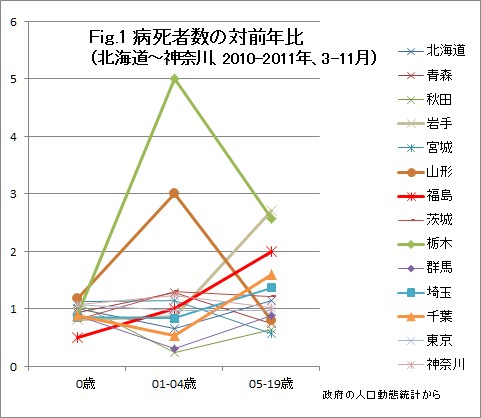
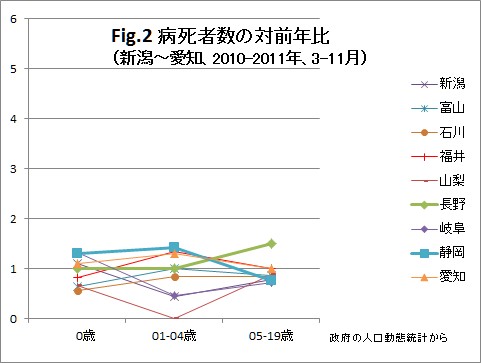
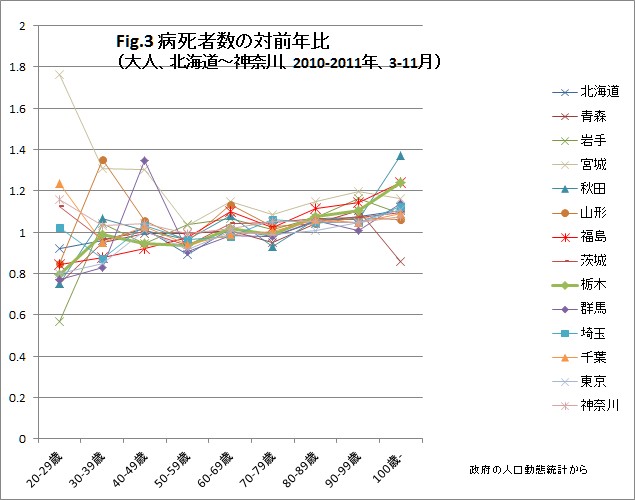
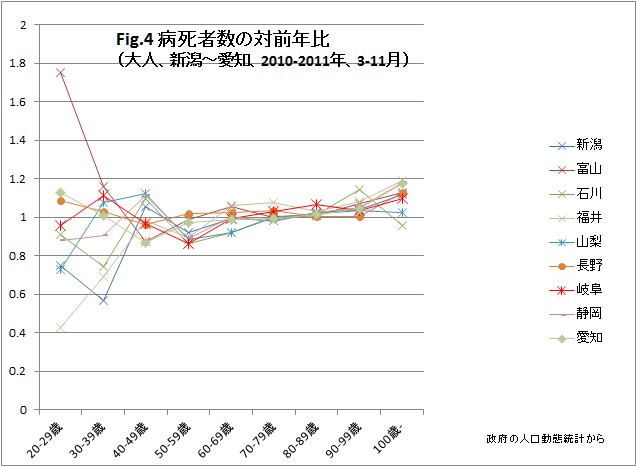
The result of the 4th aircraft monitoring carried out by Ministry of Education, Culture, Sports, Science and Technology. 2011 Dec. 16
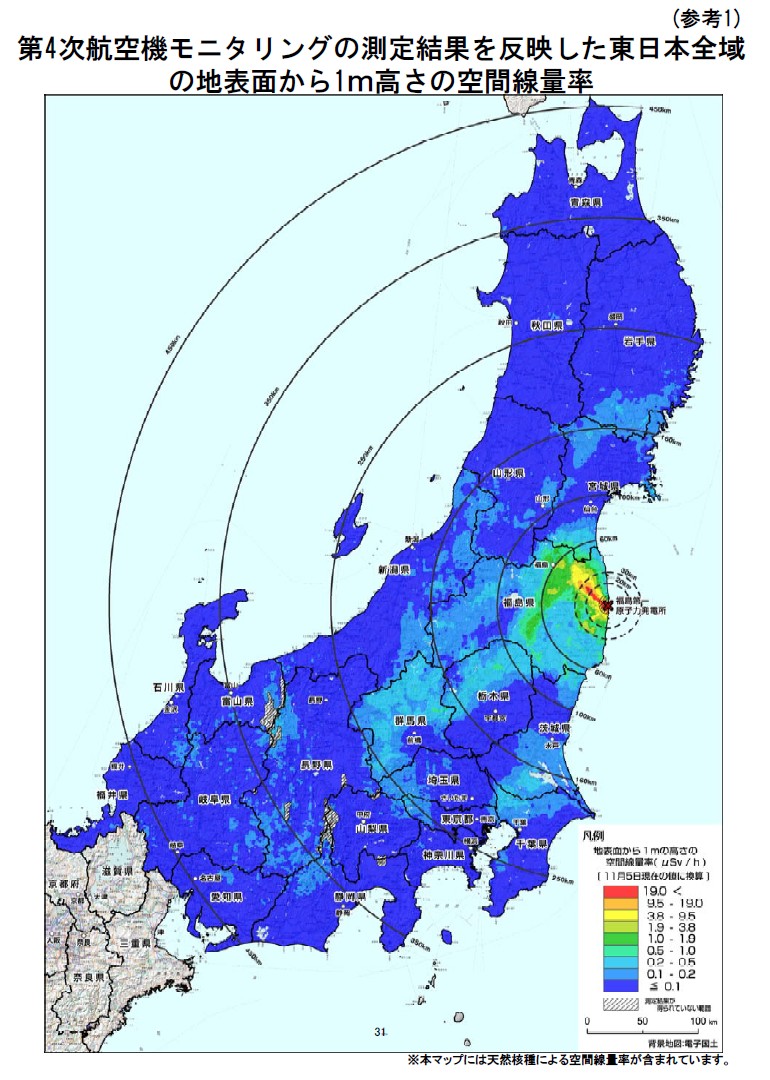
Dr. Shunich Yamashita, vice-president of Fukushima Medical University has ruled health damage surveys in Fukushima since the accident occurred. According to the result of thyroid testing of children that prefecture Fukushima published in April, morbidity of cyst is 35%.
Result of thyroid testing (2012 Apr.26)
Dr. Yamashita conducted researches of child thyroid in Nagasaki and Chernobyl before. The results are compiled along with the other study results in the opinion document by Michiyuki Matsuzaki (one of the complainant of Fukushima mass evacuation Tribunal), according to which, both in Nagasaki and Chernobyl the morbidity of cyst was less than 1%. This emphasizes the particular figure in Fukushima. However, Dr. Yamashita is reluctant to push hard to publish data.
Fukushima mass evacuation Tribunal:
[Tribunal Report 2] Prefecture Fukushima: the result of the second thyroid testing revealed child morbidity of cyst is 35%. The report also presents the opinion document that includes Dr. Yamashita's view before and after March 11
Fukushima mass evacuation Tribunal/the opinion document by Michiyuki Matsuzaki(2012 May.16)
Moreover, Dr. Yamashita advised the members of Japan Thyroid Institute not to do additional research on small nodes or cysts on January 16, 2012. Also, he told the member of Japanese Society of Nuclear Medicine that prevention of child thyroid by iodine preparation was not necessary on March 24 last year, immediately after the accident, which was a response to the advice that the society issued on 18th.
Dr. Yamashita's advice banning the additional research (2012 Jan.16)
Accident Response - Iodine Preparation not necessary, Have correct knowledge about radiation (2011 Mar.24)
For the disaster victims, especially the parents of the young children/Japanese Society of Nuclear Medicine (2011 Mar. 18)
Dr. Yamashita's survey seems to aim not at preventing health damage but at gathering guinea pigs. If this goes on, we will be killed by him eventually.
What is required in Fukushima now is to force Dr. Yamashita resign as curator of health damage survey. The other radiation-contaminated prefectures such as Chiba should also start a serious health damage survey as soon as possible.
(Mitsuyuki Ohta)
0 件のコメント:
コメントを投稿